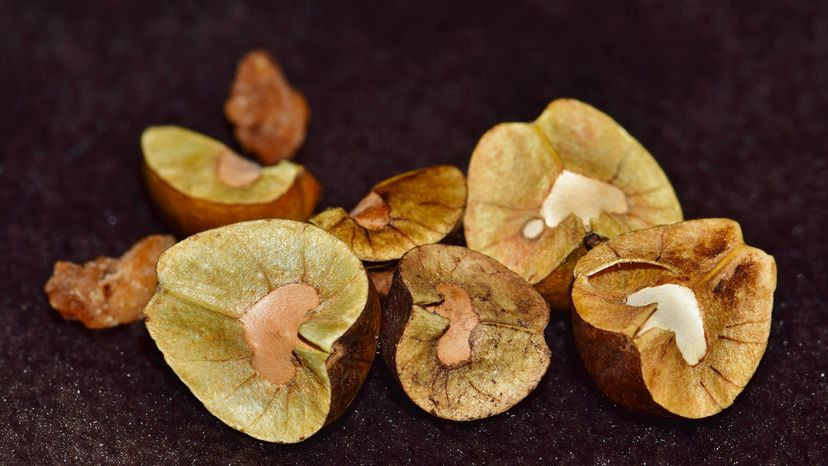Mexican jumping beans, a fascinating novelty item often found in tourist shops, aren’t beans at all! This article from gaymexico.net delves into the captivating world of these intriguing curiosities, explaining how the larvae of a specific moth species create their signature jumping motion and answering your questions about their safety.
Table of Contents
- 1. What Are Mexican Jumping Beans?
- 2. The Science Behind the Jump: How Do They Work?
- 3. A Closer Look: The Cydia saltitans Moth and Its Life Cycle
- 4. Are Mexican Jumping Beans Safe? Addressing Concerns
- 5. Where Do Mexican Jumping Beans Come From? Exploring Their Origin
- 6. How Long Do Mexican Jumping Beans “Jump”? The Life Span of the Larva
- 7. Mexican Jumping Beans as a Metaphor: LGBTQ+ Resilience in Mexico
- 8. Mexican Jumping Beans and the Environment: Sustainability and Conservation
- 9. Mexican Jumping Beans in Pop Culture: A Novelty Through the Years
- 10. FAQs About Mexican Jumping Beans
- 11. Discovering LGBTQ+ Mexico: Beyond the Jumping Beans
1. What Are Mexican Jumping Beans?
Mexican jumping beans are actually seed pods from the Sebastiania pavoniana tree, native to Mexico. These seed pods contain the larvae of the Cydia saltitans moth, which causes the jumping motion.
 Mexican jumping beans in a clear plastic box, showcasing their natural variations in color and texture.
Mexican jumping beans in a clear plastic box, showcasing their natural variations in color and texture.
2. The Science Behind the Jump: How Do They Work?
The “jumping” action is caused by the Cydia saltitans larva inside the seed pod. This larva attaches itself to the inside of the pod with silken threads.
What triggers the jumping motion?
The larva moves by bending and jerking its body, pulling and releasing the silken threads. This creates a tapping or bumping action against the inside of the pod.
Why do they jump?
Several theories exist about why the larvae cause the jumping motion:
- Thermoregulation: The larvae might be attempting to move the bean into a shadier spot, away from direct sunlight, to avoid overheating. High temperatures can be fatal to the developing larva. According to research published in Ars Technica, these movements, while seemingly random, can effectively help the beans find cooler locations.
- Defense: The movement may startle potential predators, like birds or other insects, deterring them from eating the bean.
- Positioning: The larva could be trying to position the bean in a favorable location for when it eventually emerges as a moth.
The Role of Light and Temperature
Light and temperature play a significant role in the jumping behavior. The larvae are more active in warmer conditions and when exposed to light. This is why the beans often seem to “jump” more vigorously when held in your hand or placed under a lamp.
3. A Closer Look: The Cydia saltitans Moth and Its Life Cycle
The jumping bean’s story begins with the Cydia saltitans moth. Understanding its life cycle is crucial to understanding how the beans work.
The Moth’s Reproductive Cycle
Female moths lay their eggs on the developing seed pods of the Sebastiania pavoniana tree. Once the eggs hatch, the tiny larvae burrow into the pods.
Larval Development Inside the Bean
Inside the seed pod, the larva feeds on the inner tissues. As it grows, it lines the inside of the pod with silk. This silken lining is what it uses to grip the pod and create the jumping motion.
Pupation and Moth Emergence
After several weeks, the larva pupates inside the bean. Eventually, an adult moth emerges, leaving a small hole in the seed pod.
The Life Cycle Timeline
| Stage | Duration | Description |
|---|---|---|
| Egg | Few weeks | Laid on immature green pods of the Sebastiania shrub. |
| Larva | Several months | Feeds inside the pod, causing the jumping motion. |
| Pupa | Short time | Transforms inside a cocoon within the pod. |
| Adult Moth | Brief | Emerges from the pod, mates, lays eggs, and dies. |
4. Are Mexican Jumping Beans Safe? Addressing Concerns
The question of safety is a common one when it comes to Mexican jumping beans. While they’re generally harmless, there are a few things to keep in mind.
Toxicity and Allergies
Mexican jumping beans are generally considered non-toxic. However, it’s not advisable to eat them.
Potential Choking Hazard
Because of their small size, jumping beans could be a choking hazard, especially for young children. It’s important to keep them out of reach of children under the age of three.
General Handling Precautions
Wash your hands after handling jumping beans, just as you would with any natural item.
5. Where Do Mexican Jumping Beans Come From? Exploring Their Origin
Mexican jumping beans are primarily found in Mexico.
The Native Habitat: Sebastiania pavoniana Tree
The Sebastiania pavoniana tree, which produces the seed pods, is native to Mexico, particularly the states of Sonora, Sinaloa, and Chihuahua.
Alamos, Sonora: “Jumping Bean Capital of the World”
The town of Alamos, Sonora, is often called the “Jumping Bean Capital of the World.” The beans are an important part of the local economy, providing income for many families.
Harvesting and Distribution
Local residents collect the beans by hand, usually in late summer. The beans are then sold to distributors who ship them around the world as novelty items.
6. How Long Do Mexican Jumping Beans “Jump”? The Life Span of the Larva
The length of time that a jumping bean will “jump” depends on the larva’s life cycle.
Larval Stage Duration
The larva can remain active inside the bean for several months.
Factors Affecting Activity
- Temperature: Warmer temperatures tend to increase activity, while cooler temperatures slow it down.
- Humidity: Dry conditions can dehydrate the larva, reducing its activity.
- Light: Exposure to light can also stimulate movement.
What Happens When the Larva Dies?
Once the larva dies or pupates, the jumping motion stops.
7. Mexican Jumping Beans as a Metaphor: LGBTQ+ Resilience in Mexico
The Mexican jumping bean, with its unpredictable movements and hidden life force, can serve as a metaphor for LGBTQ+ resilience in Mexico. Despite facing challenges, the LGBTQ+ community continues to thrive and make its presence known.
Overcoming Obstacles
Just as the larva inside the bean overcomes obstacles to survive, the LGBTQ+ community in Mexico has shown incredible strength in overcoming discrimination and adversity.
Celebrating Diversity and Inclusion
Like the unique jumping bean, each member of the LGBTQ+ community brings something special and valuable to Mexican society. Gaymexico.net celebrates this diversity by providing a platform for LGBTQ+ individuals to connect, share their stories, and find resources.
LGBTQ+ Rights and Progress in Mexico
Mexico has made significant strides in LGBTQ+ rights, including legalizing same-sex marriage in all states and recognizing gender identity. According to Human Rights Watch, these legal advancements reflect a growing acceptance and recognition of LGBTQ+ individuals in Mexican society.
8. Mexican Jumping Beans and the Environment: Sustainability and Conservation
The harvesting of Mexican jumping beans can have an impact on the environment. It’s important to consider sustainability and conservation efforts.
Sustainable Harvesting Practices
Sustainable harvesting practices can help protect the Sebastiania pavoniana trees and the surrounding ecosystem. This includes only collecting a certain percentage of the beans and avoiding damage to the trees.
Conservation Efforts
Supporting local conservation efforts can help ensure the long-term survival of the Sebastiania pavoniana trees and the unique ecosystem they support.
Eco-Tourism and Responsible Travel
When visiting areas where jumping beans are harvested, consider supporting eco-tourism initiatives that promote responsible travel and conservation.
9. Mexican Jumping Beans in Pop Culture: A Novelty Through the Years
Mexican jumping beans have been a popular novelty item for decades. They have appeared in movies, TV shows, and cartoons, often as a source of amusement and wonder.
A Symbol of Curiosity and Wonder
The beans’ mysterious jumping motion has captured the imagination of people of all ages, making them a symbol of curiosity and wonder.
Novelty Item and Souvenir
They are often sold as souvenirs in tourist shops, reminding visitors of their travels and the unique culture of Mexico.
The Enduring Appeal
Despite the rise of modern technology, Mexican jumping beans continue to hold a special place in popular culture, reminding us of the simple joys of nature and the magic of the natural world.
10. FAQs About Mexican Jumping Beans
Here are some frequently asked questions about Mexican jumping beans:
1. What exactly are Mexican jumping beans?
Mexican jumping beans are seed pods from the Sebastiania pavoniana tree that contain the larva of the Cydia saltitans moth, causing them to “jump”.
2. How do Mexican jumping beans jump?
The larva inside the seed pod moves by bending and jerking its body, pulling and releasing silken threads attached to the inside of the pod.
3. Are Mexican jumping beans dangerous?
No, they are generally considered non-toxic, but they could be a choking hazard for young children.
4. Where do Mexican jumping beans come from?
They are native to Mexico, particularly the states of Sonora, Sinaloa, and Chihuahua.
5. How long do Mexican jumping beans continue to jump?
The larva can remain active inside the bean for several months.
6. What happens when the larva dies?
Once the larva dies or pupates, the jumping motion stops.
7. Can I eat Mexican jumping beans?
While non-toxic, it’s not advisable to eat them.
8. Are there conservation concerns related to harvesting jumping beans?
Yes, sustainable harvesting practices are important to protect the Sebastiania pavoniana trees and the surrounding ecosystem.
9. How should I store Mexican jumping beans?
Store them in a cool, dry place away from direct sunlight.
10. Can I raise the moth from a jumping bean?
It’s possible, but requires specific conditions and careful monitoring.
11. Discovering LGBTQ+ Mexico: Beyond the Jumping Beans
While Mexican jumping beans offer a glimpse into the country’s natural wonders, Mexico also boasts a vibrant and welcoming LGBTQ+ scene.
LGBTQ+ Friendly Destinations in Mexico
Mexico City, Puerto Vallarta, and Cancun are just a few of the many LGBTQ+ friendly destinations in Mexico. These cities offer a variety of gay bars, clubs, hotels, and cultural events.
LGBTQ+ Events and Festivals
Mexico hosts a number of LGBTQ+ pride festivals and events throughout the year. These celebrations are a great way to experience the local culture and connect with the LGBTQ+ community.
Resources and Support for LGBTQ+ Travelers
Gaymexico.net provides valuable resources and information for LGBTQ+ travelers visiting Mexico, including guides to LGBTQ+ friendly destinations, news about LGBTQ+ rights, and connections to local organizations.
Exploring Mexico as an LGBTQ+ traveler is an enriching experience, combining cultural immersion with the warmth and acceptance of the local community.
Ready to explore the beauty and diversity of Mexico? Visit gaymexico.net for comprehensive travel guides, event listings, and resources to help you plan your perfect LGBTQ+ adventure. Discover safe and welcoming destinations, connect with the local community, and experience the best of Mexican culture.
Contact us today:
Address: 3255 Wilshire Blvd, Los Angeles, CA 90010, United States
Phone: +1 (213) 380-2177
Website: gaymexico.net
